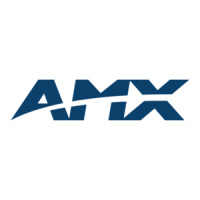Displaying Stream Content
135
Modero VG Series Touch Panels - Instruction Manual
5. Click OK to enter the information and proceed to the Administration page which provides both a descriptive overview of the
program stream and lists the currently used firmware.
6. Determine the data throughput available on the network being used by the source encoder. This information determines which
Encoder Profile and Transport Protocol will be used to encode the outgoing media stream.
7. Access Stream Profiles page (FIG. 132) by clicking the Stream Prof iles link from within the Navigation frame. This page allows
a user to both configure the properties of the outgoing media stream and setup the properties associated with
communicating the stream to an external IP-enabled device capable of receiving and processing the data.
8. From the Prof ile field, click on the drop-down arrow and from the available list, choose the desired encoder setting which
conforms to the available data throughput on your network. Although the default selection is Home Theater (Max), the user
can choose from up to 6 pre-created entries and one Custom entry which makes every field user-definable.
For the purpose of these procedures, we’ve been informed that our network can handle the full 6 Mbps data throughput, so
we’ll select Home Theater (Max).
9. Click the Apply button to save the encoding profiles to the MAX (FIG. 133).
10. From the Stream section of the page, locate the Transport Protocol field and use the drop-down arrow to select a desired
protocol. For the purposes of these procedures, we’ve chosen UDP as the protocol (FIG. 133).
An UDP protocol is typically used with higher-bandwidth streams and only requires the entry of a single Target Port
because both the video and audio are combined into a single media stream. With this method, the Modero panel always
utilizes an audio port value of two greater than that used by the Target Port.
An RTP protocol is typically used both with lower-bandwidth streams and when user wants to purposely separate the video
and audio information into two distinct streams. With this method, the Target Audio Port must be manually entered and
CAN NOT be the same value as the Target Port used for video.
11. Enter the previously obtained IP Address of the target Modero panel (FIG. 131) into the Ta rg et Address field (FIG. 133).
12. Enter a numeric value into the Target Port field. This field corresponds to the port on the destination device where the
outgoing video (audio/video) stream is being directed to.
It is recommended that this value not currently be used by another port on the target device.
It is recommended that the following ports also not be used: 21, 22, 23, 80, 443, and 1319.
For the purposes of these procedures, we’ve chosen to use 5000 as the video Target Port.
13. If using RTP as a Transport Protocol, enter a value into the Ta rg et A udio Port field. This field corresponds to the port on the
destination device where the audio only portion of the stream is being directed to. This value can not match the value entered
into the Targ et Po rt f ield above. If using UDP as a Transport Protocol, this field becomes disabled and unused since the both
the audio and video content is being combined into a single stream.
For the purposes of these procedures, we are not required to enter a Target Audio Port value because the A/V content is not
begin streamed separately (FIG. 133).
FIG. 132
Stream Prof iles page
Encoding Presets (including Custom)
Video Encoding Parameters
Stream Destination
Communication/Connection
Audio Encoding Parameters
Parameters
(use even port values)

